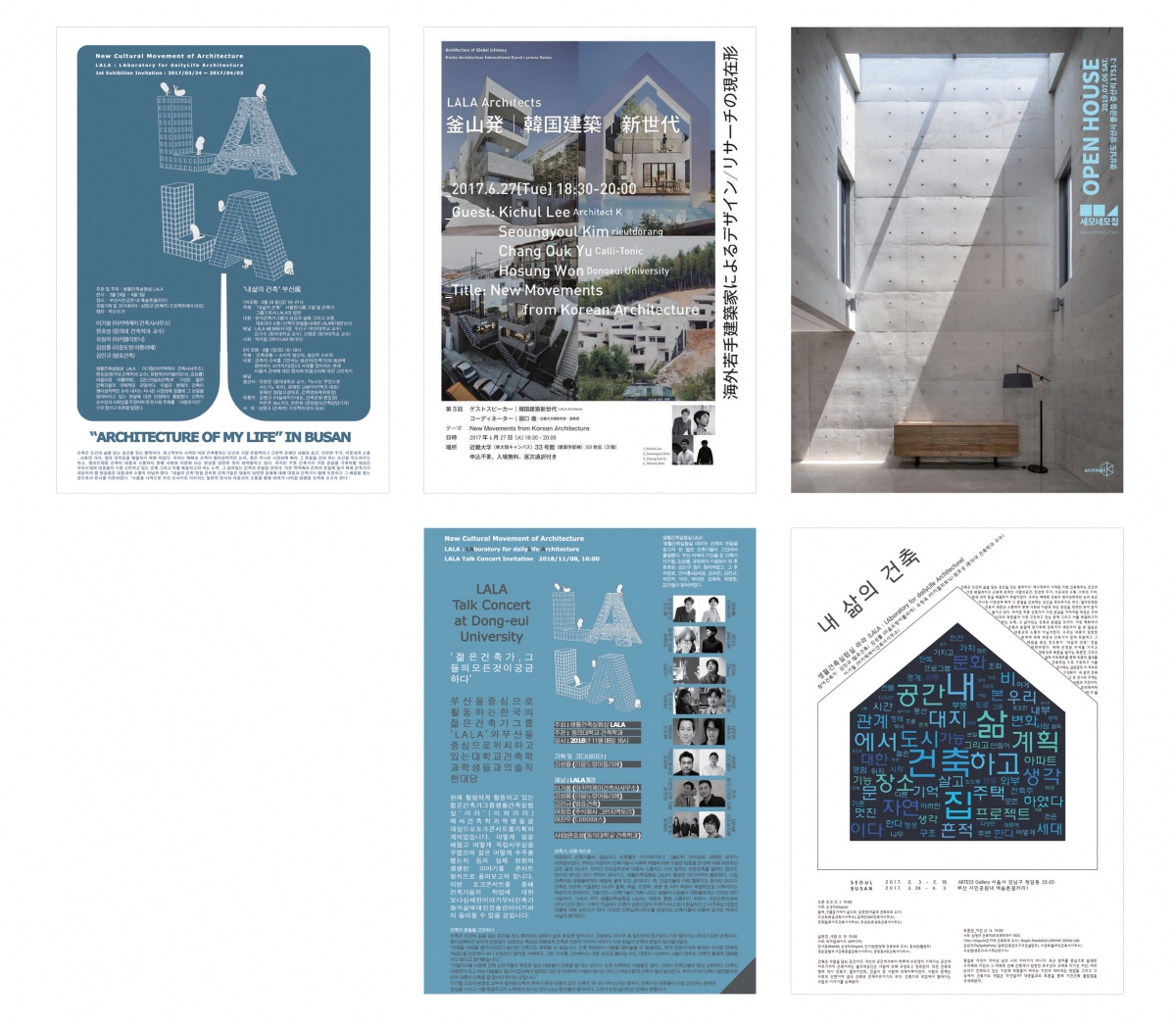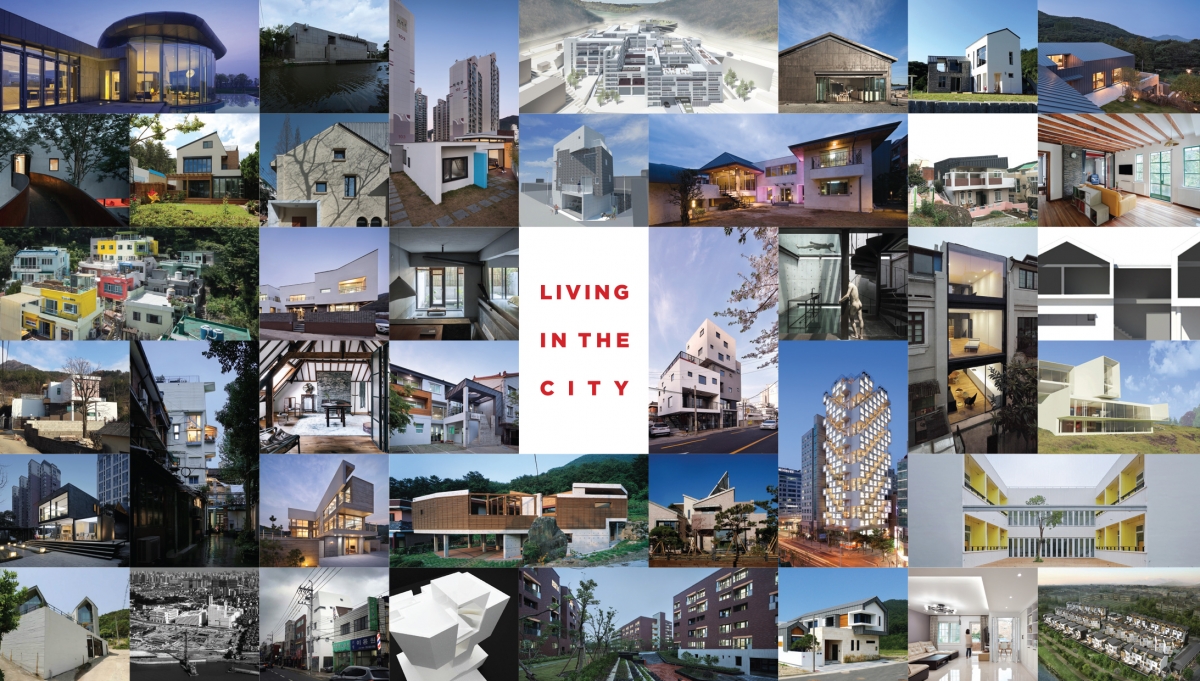LALA (Living Architecture LAb)
Chief producerㅣLee Kichul
MemberㅣKang Jingyu, Kim Mingyu, Kim Seongryoul, Kim Yoojin, Baek Jiyung, Shin Hyukhyu, Won Hosung, Jo Jaeduk, Heo Jinwoo, Yu Changwook, Lee Jae, Jung Woogsik
Period of operationㅣNov. 2016 – ongoing
Main programmeㅣseminar, open house, talk concert, sight seeing
Operational aimsㅣA causal meeting between familiar colleagues who work in the architectural field.


interview Lee Kichul principal, architect-K × Choi Eunhwa
Choi Eunhwa (Choi): How was LALA launched?
Lee Kichul (Lee): When I met and talked with Kim Seongryoul and Yu Changwook, I had the feeling that we would see each other often. This was due to our impassioned, incisive conversations, threaded with themes such as the audacious projects led by young architects, and the contrasting modest desire to instigate some kind of change in Busan. Won Hosung and Kim Mingyu also participated in this conversation under the title of LALA and we began to congregate as as a group. LALA is a collective founded purely on the principles of camaraderie. In fact, the aim of the group is not so much comradeship, but a prevailing belief that it is people that count. It could be described as a spontaneous, light-hearted and excitable band of mock conspirators, who are always desirous of being a bit more sophisticated and useful.
Choi: What do you talk about when you meet? What are the core interests of LALA?
Lee: The themes we talk about: ‘whose recent work stands out?’; ‘this project is cool!’; ‘I managed to persuade a client by saying...’; ‘I went to this lecture and it was great because...’; ‘the metalwork team for such and such project was happy to wrap everything up on site’; ‘watch out when you work with this contractor as the cost increases with each project’; and so on. We talk about all kinds of things from the latest architectural trends to the most eccentric of on-site anecdotes. While our conversations seem to be all over the place – each topic or story lasting no more than 5 minutes – a single evening is jampacked with all sorts of thoughts about architecture. These conversations help us in our practice and provide a general sense of comfort us. Of course, we also discuss grander themes, once in a while.
Choi: What are your thoughts on the need for greater solidarity between architects?
Lee: As architects we needed a creative environment that would be like a playground. We needed somewhere we could just have fun and escape from the seriousness of architectural practice and the realities of managing a firm. We’re not conscious of that ‘solidarity for survival’ or ‘one voice one group’. Nevertheless, we do share our interests within the boundaries of where we live and work. We also attempt to initiate exchange between architects based in similar urban environments to that of Busan. We aim to create contact between cities that are the second cities of their nation and have an established cultural landscape. The object of such exchange is cities that are the second largest city of a country with an established cultural zone, and we have had young architects visiting from Osaka on several occasions. We are also preparing joint exhibitions with architects in Barcelona, Porto and Milan.
Choi: As a group of practicing architects, you have at times carried out joint projects under the moninkers of Producer (PD) and Chief Producer (CP).
Lee: Once a member of LALA expresses their desire to carry out a certain project or event, that member becomes the project’s PD, and the project is launched once other members join this cause. Each of the projects, such as the seminar, open house, talk concerts, sight seeings and independent exhibitions have their own PDs and production methods. The CP collates the opinions of each member on the launch of the project. If negative opinions surface, this is made public, and a meeting is hosted to reconsider whether the project should be carried out or not. The present role of the CP is as a ‘non-partial master of ceremonies’. If one were to think of this a children’s game of catch, then the CP would be ‘It’.
Busan Architecture Festival
ChairmanㅣSeo Euitaek
Period of operationㅣ2001 – ongoing
Main programmeㅣlaunching design competition, supporting project for creative activities and professionals, international exchange project, architectural culture event
Websiteㅣbiacf.or.kr


The Busan Architecture Festival (hereinafter BAF) is a registered corporation that operates a whole host of events related to the architecture and the urban environment of Busan. The municipality of Busan launched and supported the BAF in 2001 as one of the representative festivals of Busan, alongside the Busan International Film Festival. Celebrating its birth twenty years ago today, it has a longer legacy than that of the Seoul Biennale of Architecture and Urbanism. It has grown both in terms of its programme and its capacity with the passing of time. I recommend the BAF for two main reasons. The fact that it has annually fostered diverse and unique perspectives in regard to the city and architecture within Busan, and that it has acted to reflect on these actions. And yet there remain many architects who do not know about the BAF and have to be introduced to its activities, despite the continued work of its organisers over the past twenty years.
The festival has opened up a broad spectrum of themes, such as ‘Globalism And Regionalism’ (2001 – 2002), ‘Landscape, City Scape and Sea Scape of Architecture in a Maritime City Busan’ (2003 – 2004), ‘Busan – The Gateway to Asia – Pacific’ (2005 – 2006), ‘Port City Busan’ (2005 – 2006), ‘Conservation & Innovation’ (2009 – 2010), ‘Communication and Consilience’ (2011), ‘Architectural Well-being – Sharing & Regeneration’ (2012 – 2013), ‘SPACE-SYMBIOSIS’ (2014 – 2015), ‘Living in the City’ (2016 – 2017), and ‘What Houses Should We Build’ (2018 – 2019). I note this as the festival contemplates and aims to respond to contemporary issues facing Busan, such as the geopolitical characteristics of the city and its architecture, the future directions for regeneration and conservation as a modern city, and architectural approaches regarding housing and welfare.
In terms of its programme, the Festival, hosted every September, is accessible to the public, familiarizing them with key local works and key concepts and enabling greater access to architecture through indoor and outdoor exhibitions, lectures, architecture tours and seminars of multiple sectors. Projects like the HOPE project, which repairs houses, the international architecture workshop, the Busan city architecture tour, and the architectural culture commentator training are sustained throughout the year. Yu Changwook and Kim Seongryoul have participated in HOPE, and I have planned and managed the academy that fosters architectural culture docents and the Busan city architecture tour. As a platform that is more evocative of expressions such as attachment compared to the interventions by LALA members.
From this year on, municipal funding has been drastically cut, and the festival faces a forking path by which it must persist in its activities through self-sustained funding and projects. It is simultaneously a moment in time that requires greater interest and support from the architectural scene, as well as grander expectations as an opportunity for the festival to undergo a renaissance and transform into a freer, more liberal platform. As it is takes place around the same time of the year as the Busan International Film Festival, I hope that visitors to Busan don’t forget to make the time for architectural happenings.
UC Berkeley. He trained as an architect at Frederic Schwartz Architects, New York, USA and Space Group, Korea. He opened his own office, architect-K, in 2012 and has received a number of awards for his projects, including the Chicago Athenaum International Award, Architecture Master Prize, Achon Special Award, and Korean Architecture Award.




